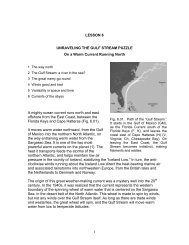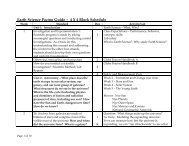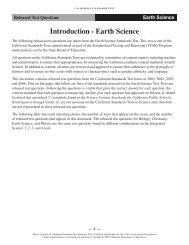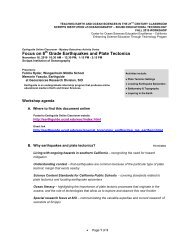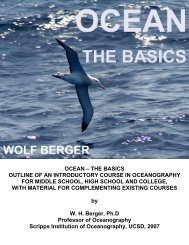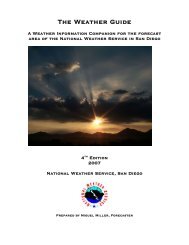Density Presentation 1 [.pdf] - Earthguide
Density Presentation 1 [.pdf] - Earthguide
Density Presentation 1 [.pdf] - Earthguide
Create successful ePaper yourself
Turn your PDF publications into a flip-book with our unique Google optimized e-Paper software.
Mission Bay High School<br />
<strong>Density</strong> as a Force<br />
that drives Earth<br />
Science Process
Theme<br />
Relative density and convection in earth<br />
systems<br />
• Gases: atmosphere<br />
• Liquids: water in lakes and oceans<br />
• Deformable solids: earth’s crust and mantle<br />
• In lab experiments<br />
• Tie to real world examples<br />
Big idea
What is density?<br />
What is convection?<br />
Focus questions<br />
What is the relationship between relative<br />
density and convection?<br />
Which earth materials (air, water, rocks)<br />
convect?<br />
How does convection influence weather?<br />
Ocean circulation? Earth’s crust and mantle?<br />
What happens to the process of convection<br />
under low gravity conditions (for example in<br />
space)?
Your job<br />
Work in teams<br />
Work though the experiments<br />
Keep accurate lab notes<br />
Calculate values from measured<br />
results<br />
Participate in small group and<br />
large group discussion
Outline<br />
Outline: in 4 bullets<br />
• Relative density and convection in<br />
water.<br />
• Relative density in air; importance<br />
of heat capacity.<br />
• Relative density of rocks (Plate Tectonics)<br />
• Seismic energy propagation
Tie in-lab experiments to real<br />
world processes<br />
Cuyamacha Lake
Experiment 1<br />
Influence of temperature on density<br />
engage Cuyamacha Lake<br />
Is the water in the lake more dense or less<br />
dense in the summer than in the winter?<br />
Day/night?<br />
Which part of the lake (surface or bottom)<br />
changes temperature first when solar<br />
radiation changes?<br />
How might solar radiation and air temperature<br />
change from summer to winter (or day to<br />
night) affect circulation in the lake?<br />
Why is water circulation in the lake important<br />
for fish populations?
Experiment 1<br />
Cool water<br />
to 5 o C<br />
ice<br />
Hot plate<br />
Using dropper, carefully add<br />
colored hot water to cold water<br />
Observe layering<br />
Record data<br />
Heat water<br />
to 40 o C<br />
Add food<br />
coloring to<br />
hot water
http://terraserver.microsoft.com/<br />
Pacific<br />
Ocean<br />
San Diego River
Experiment Experiment 2<br />
Influence Influence of composition composition on density<br />
density<br />
engage<br />
Is San Diego river water more saline or less saline<br />
than the Pacific Ocean seawater?<br />
Is river denser or less dense than seawater? Why?<br />
How might the distribution of river water and<br />
seawater at the mouth of the river be different on a<br />
rainy day than on a sunny day?<br />
How might the distribution of river water and<br />
seawater be different when the tide is rising than<br />
when it is falling?<br />
Why is the distribution of salinity (and density of the<br />
water) in the San Diego river important for the plants<br />
and animals that live there?
Experiment 2<br />
Measure salinity using the refractometer<br />
fresh water salt water<br />
Add food<br />
coloring to<br />
salt water<br />
Gently and carefully<br />
transfer salt water<br />
Use a dropper or pour<br />
Observe layers<br />
Record data
Experiment 3<br />
Convection<br />
engage<br />
What do you think happens when<br />
a pan of water is heated on one<br />
side and cooled on the other side?<br />
Why?<br />
How might uneven heating affect<br />
the currents in the oceans?
Experiment 3<br />
red food color blue food color<br />
50 o C 0 o C<br />
Record observations
Iced water Heated water
explain<br />
What is THERMOHALINE<br />
circulation?<br />
Why is thermohaline circulation<br />
important in lakes?<br />
Why is thermohaline circulation<br />
important in the ocean?
Science magazine July 2005
Relative Relative density density and convection<br />
convection<br />
in the atmosphere<br />
atmosphere<br />
Focus questions<br />
What causes air to rise?<br />
What causes air to fall?<br />
Why do coastal regions have more<br />
moderate climate than inland<br />
regions?
http://prism.asu.edu/clouds/movies/rain.mov
Experiment 4<br />
Temperature<br />
inside<br />
beaker?<br />
Temperature<br />
outside<br />
column?<br />
Water and dry ice<br />
Put column over dry ice<br />
Observe direction of<br />
vapor flow<br />
Remove column<br />
Observe the direction of<br />
vapor flow<br />
Record data<br />
Wear glove to<br />
handle dry ice!!!
extend<br />
Is the direction of vapor flow in your<br />
beaker/PVC column experiment more<br />
similar to what happens when<br />
cumulonimbus clouds form over the<br />
Laguna Mountains in late summer or<br />
more similar to what happens to air<br />
masses that flow from glaciers? Why?


![Density Presentation 1 [.pdf] - Earthguide](https://img.yumpu.com/18214521/1/500x640/density-presentation-1-pdf-earthguide.jpg)
